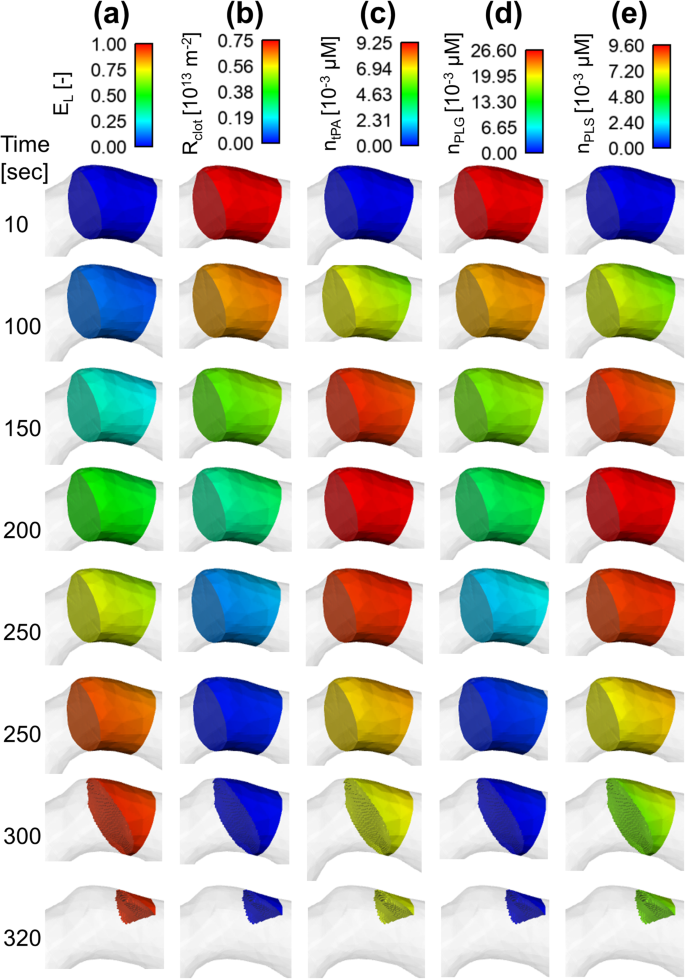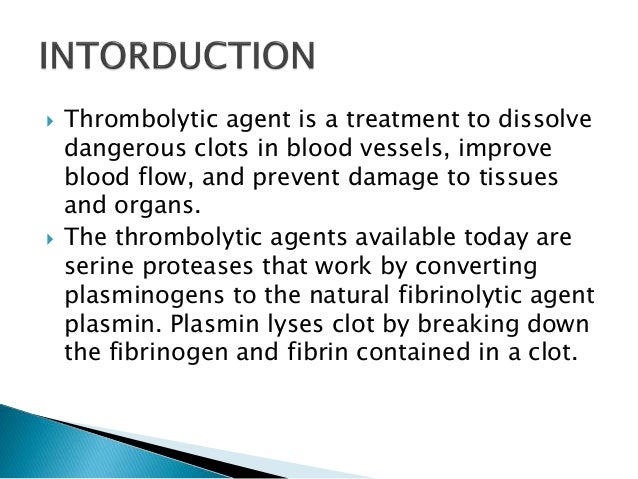
Tissue Plasminogen Activator for Acute Ischemic Stroke (Alteplase, Activase®) A stroke occurs when the blood supply to brain tissue is blocked by a blood clot (ischemic stroke), or when a blood vessel in the brain ruptures (hemorrhagic stroke), causing brain cells to die and leading to functional impairments.
Tpa Clot Buster Side Effects
Irs rental income guide. Blood clots occur when groups of blood cells bunch up and stick together. Clots can be caused by injury or disease. Depending on where they form, blood clots can cause tissue damage resulting in serious injury or even death. Dissolving clots is the best way to prevent or minimize damage, and it can be very effective, if done in time. This process is called thrombolysis, and is accomplished by the use of medications that work to digest clots, causing them to dissolve.
There are three main types of thrombolytic agents, the medicines that work to dissolve blood clots. These agents are effective because they cause an increase in the amount of plasmin in the blood. Plasmin is a naturally occurring agent that dissolves clots. It is created from plasminogen by various enzymes in the body in response to the presence of blood clots or other factors.
Tpa Clot Agent
Inserted the gene for human tPA (tissue plasminogen activator), a common clot-busting agent, into a healthy leg vein in rabbits. The vein, which began pumping out large quantities of tPA, was then used as a bypass for an adjacent artery constricted by a blood. Tissue plasminogen activator (tPA) is a clot-specific fibrinolytic agent shown to be effective in decreasing postsurgical fibrin formation and enhancing filtration after trabeculectomy. IV tPA travels in the blood throughout the body and can attack the blood clot. IA tPA is given through a catheter (straw) right where the clot is. IV tPA must be given very early after a stroke by a neurologist, emergency room physician, or other physician specifically trained in stroke. Thrombolytic or 'clot-busting' drugs offer an emergency treatment option for some people who are having a stroke. These medications, which include an agent called a tissue plasminogen activator (t-PA), halt the stroke by dissolving the blood clot that is blocking blood flow to the brain.
17 brokerages have issued 1-year target prices for Energy Transfer's stock. Their forecasts range from $6.00 to $16.00. On average, they anticipate Energy Transfer's share price to reach $10.06 in the next twelve months. This suggests a possible upside of 60.5% from the stock's current price. Shares of Energy Transfer (NYSE:ET) saw some unusual options activity on Tuesday. Following the unusual option alert, the stock price moved up to $6.97. Investors may trade in the Pre-Market (4:00-9:30 a.m. ET) and the After Hours Market (4:00-8:00 p.m. Participation from Market Makers and ECNs is strictly voluntary and as a result, these. E t stock price. Stock analysis for Energy Transfer LP (ET:New York) including stock price, stock chart, company news, key statistics, fundamentals and company profile.


The first of these three agents is streptokinase, a medication created from streptococci bacteria. Streptokinase works well to dissolve blood clots and is the least expensive of the thrombolytic agents. The problem with this drug is that it has been known to cause negative reactions in some patients, particularly unfavorable immune system responses, so it cannot be used in all situations.

Tissue Plasminogen Activator for Acute Ischemic Stroke (Alteplase, Activase®) A stroke occurs when the blood supply to brain tissue is blocked by a blood clot (ischemic stroke), or when a blood vessel in the brain ruptures (hemorrhagic stroke), causing brain cells to die and leading to functional impairments.
Tpa Clot Buster Side Effects
Irs rental income guide. Blood clots occur when groups of blood cells bunch up and stick together. Clots can be caused by injury or disease. Depending on where they form, blood clots can cause tissue damage resulting in serious injury or even death. Dissolving clots is the best way to prevent or minimize damage, and it can be very effective, if done in time. This process is called thrombolysis, and is accomplished by the use of medications that work to digest clots, causing them to dissolve.
There are three main types of thrombolytic agents, the medicines that work to dissolve blood clots. These agents are effective because they cause an increase in the amount of plasmin in the blood. Plasmin is a naturally occurring agent that dissolves clots. It is created from plasminogen by various enzymes in the body in response to the presence of blood clots or other factors.
Tpa Clot Agent
Inserted the gene for human tPA (tissue plasminogen activator), a common clot-busting agent, into a healthy leg vein in rabbits. The vein, which began pumping out large quantities of tPA, was then used as a bypass for an adjacent artery constricted by a blood. Tissue plasminogen activator (tPA) is a clot-specific fibrinolytic agent shown to be effective in decreasing postsurgical fibrin formation and enhancing filtration after trabeculectomy. IV tPA travels in the blood throughout the body and can attack the blood clot. IA tPA is given through a catheter (straw) right where the clot is. IV tPA must be given very early after a stroke by a neurologist, emergency room physician, or other physician specifically trained in stroke. Thrombolytic or 'clot-busting' drugs offer an emergency treatment option for some people who are having a stroke. These medications, which include an agent called a tissue plasminogen activator (t-PA), halt the stroke by dissolving the blood clot that is blocking blood flow to the brain.
17 brokerages have issued 1-year target prices for Energy Transfer's stock. Their forecasts range from $6.00 to $16.00. On average, they anticipate Energy Transfer's share price to reach $10.06 in the next twelve months. This suggests a possible upside of 60.5% from the stock's current price. Shares of Energy Transfer (NYSE:ET) saw some unusual options activity on Tuesday. Following the unusual option alert, the stock price moved up to $6.97. Investors may trade in the Pre-Market (4:00-9:30 a.m. ET) and the After Hours Market (4:00-8:00 p.m. Participation from Market Makers and ECNs is strictly voluntary and as a result, these. E t stock price. Stock analysis for Energy Transfer LP (ET:New York) including stock price, stock chart, company news, key statistics, fundamentals and company profile.
The first of these three agents is streptokinase, a medication created from streptococci bacteria. Streptokinase works well to dissolve blood clots and is the least expensive of the thrombolytic agents. The problem with this drug is that it has been known to cause negative reactions in some patients, particularly unfavorable immune system responses, so it cannot be used in all situations.
Urokinase is another agent used to dissolve blood clots. It exists naturally in the human system, so there are no problems with immune system rejection, making it safer to use. The down side is that it is difficult to purify urokinase, making the agent a costly choice. When this medicine is used to dissolve blood clots, it is normally combined with other drugs because of it high cost.
The third agent is tissue plasminogen activator (tPA), a medication discovered around 1980 and originally derived from human uterine tissue. tPA has been used successfully to dissolve clots, providing useful therapy for deep vein thrombosis (DVT), heart attack, pulmonary embolism and stroke. The biggest drawback of this medicine is its high cost. Researchers have had some success in cloning hamster genes to create large quantities of tPA, which should help to bring the cost down significantly over time.
Anticoagulant drugs help to dissolve blood clots by preventing them from getting bigger and allowing the body's natural defenses to actually shrink the clot. Coumadin, aspirin and heparin are all used to prevent clots from getting bigger. A study by the University of Colorado Health Sciences Center also concluded that aerobic exercise increases the amount of tPA in the blood, helping to dissolve blood clots. Whichever method is used, blood clots are serious and should be treated as quickly as possible to minimize the potential risks.

